Chapter: Compilers : Principles, Techniques, & Tools : A Simple Syntax-Directed Translator
Lexical Analysis
Lexical Analysis
1 Removal of White Space and
Comments
2 Reading Ahead
3 Constants
4 Recognizing Keywords and
Identifiers
5 A Lexical Analyzer
6 Exercises for Section 2.6
A lexical analyzer reads characters from the input and groups them into
"token objects." Along with a terminal symbol that is
used for parsing decisions, a token
object carries additional information in the form of attribute values.
So far, there has been no need
to distinguish between the
terms "token" and "terminal," since the parser
ignores the attribute values that are carried by a token. In this section, a
token is a terminal along with additional information.
A sequence of input characters that comprises a single token is called a
lexeme. Thus, we can say that the lexical analyzer insulates a parser from the
lexeme representation of tokens.
The lexical analyzer in this section allows numbers, identifiers, and
"white space" (blanks, tabs, and newlines) to appear within
expressions. It can be used to extend the expression translator of the previous
section. Since the expression grammar of Fig. 2.21 must be extended to allow
numbers and identifiers, we shall take this opportunity to allow multiplication
and division as well. The extended translation scheme appears in Fig. 2.28.
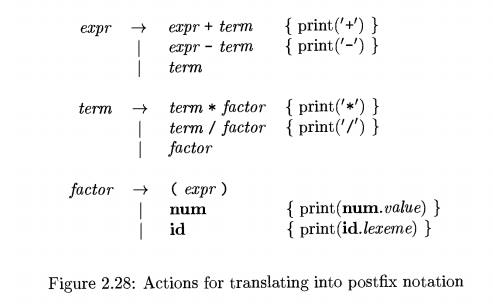
In Fig. 2.28, the terminal n u m is assumed
to have an attribute imm.value, which gives the integer value corresponding to
this occurrence of num . Termi-nal id has a string-valued attribute written as
id.lexeme; we assume this string is the actual lexeme comprising this instance
of the token id.
The pseudocode fragments used to illustrate the workings of a lexical
ana-lyzer will be assembled into Java code at the end of this section. The
approach in this section is suitable for hand-written lexical analyzers.
Section 3.5 de-scribes a tool called Lex that generates a lexical analyzer from
a specification. Symbol tables or data structures for holding information about
identifiers are considered in Section 2.7.
1. Removal of White Space and
Comments
The expression translator in Section 2.5 sees every character in the input,
so extraneous characters, such as blanks, will cause it to fail. Most languages
allow arbitrary amounts of white space to appear between tokens. Comments are
likewise ignored during parsing, so they may also be treated as white space.
If white space is eliminated by the lexical analyzer, the parser will
never have to consider it. The alternative of modifying the grammar to
incorporate white space into the syntax is not nearly as easy to implement.
The pseudocode in Fig. 2.29 skips white space by reading input
characters as long as it sees a blank, a tab, or a newline. Variable peek holds the next input character.
Line numbers and context are useful within error messages to help pinpoint
errors; the code uses variable line
to count newline characters in the input.

2. Reading Ahead
A lexical analyzer may need to read ahead some characters before it can
decide on the token to be
returned to the parser. For example, a lexical analyzer for C or Java must read ahead after it sees the character >. If the next character is =,
then > is part of the character sequence >=, the lexeme for the token for
the "greater than or equal to" operator. Otherwise > itself forms
the "greater than" operator, and the lexical analyzer has read one
character too many.
A general approach to reading ahead on the input, is to maintain an
input buffer from which the lexical analyzer can read and push back characters.
Input buffers can be justified on efficiency grounds alone, since fetching a
block of characters is usually more efficient than fetching one character at a
time. A pointer keeps track of the portion of the input that has been analyzed;
pushing back a character is implemented by moving back the pointer. Techniques
for input buffering are discussed in Section 3.2.
One-character read-ahead usually suffices, so a simple solution is to
use a variable, say peek, to hold the
next input character. The lexical analyzer in this section reads ahead one
character while it collects digits for numbers or characters for identifiers;
e.g., it reads past 1 to distinguish between 1 and 10, and it reads past t to distinguish between t and true .
The lexical analyzer reads ahead only when it must. An operator like *
can be identified without reading ahead. In such cases, peek is set to a blank, which will be skipped when the lexical
analyzer is called to find the next token. The invariant assertion in this
section is that when the lexical analyzer returns a token, variable peek either holds the character beyond
the lexeme for the current token, or it holds a blank.
3. Constants
Anytime a single digit appears in a grammar for expressions, it seems
reasonable to allow an arbitrary integer constant in its place. Integer
constants can be allowed either by creating a terminal symbol, say num, for such constants or by
incorporating the syntax of integer constants into the grammar. The job of
collecting characters into integers and computing their collective numerical
value is generally given to a lexical analyzer, so numbers can be treated as
single units during parsing and translation.
W h en a sequence of digits appears in the input stream, the lexical
analyzer passes to the parser a token consisting of the terminal n u m along with an integer-valued
attribute computed from the digits. If we write tokens as tuples enclosed
between ( ), the input 31
+ 28 + 59 is transformed into the sequence
(num, 31) (+) (num, 28) (+) (num, 59)
Here, the terminal symbol + has no attributes, so its tuple is simply
(+). The pseudocode in Fig. 2.30 reads
the digits in an integer and accumulates the value of the integer using
variable v.
if ( peek holds a digit ) {
v = 0;
do {
v = v * 10 + integer value of digit peek;
peek = next input character;
} while ( peek holds a digit ); return token (num, v);
}
Figure 2.30: Grouping digits into
integers
4. Recognizing Keywords and
Identifiers
Most languages use fixed character strings such as for, do, and if, as
punctua-tion marks or to identify constructs. Such character strings are called
keywords.
Character strings are also used as identifiers to name variables,
arrays, func-tions, and the like. Grammars routinely treat identifiers as
terminals to sim-plify the parser, which can then expect the same terminal, say
id, each time any identifier appears
in the input. For example, on input
|
count =
count + increment; |
(2.6) |
the parser works with the terminal stream id = id + id. The token for id
has an attribute that holds the lexeme. Writing tokens as tuples, we see that
the tuples for the input stream (2.6)
are
(id, "count") (=) (id,
"count") (+) (id, "increment") (;)
Keywords generally satisfy the rules for forming identifiers, so a
mechanism is needed for deciding when a lexeme forms a keyword and when it
forms an identifier. The problem is easier to resolve if keywords are reserved; i.e., if they cannot be used
as identifiers. Then, a character string forms an identifier only if it is not
a keyword.
The lexical analyzer in this section solves two problems by using a
table to hold character strings:
• Single Representation. A string table can insulate the rest of the compiler from the representation of strings, since the phases of the
compiler can work with references or pointers to the string in the table.
References can also be manipulated more efficiently than the strings
themselves.
• Reserved Words. Reserved words can be implemented by initializing the string table with the reserved strings
and their tokens. When the lexical analyzer reads a string or lexeme that could
form an identifier, it first checks whether the lexeme is in the string table.
If so, it returns the token from the table; otherwise, it returns a token with
terminal id.
In Java, a string table can be implemented as a hash table using a class
called Hashtable. The declaration
Hashtable words = n e w HashtableQ;
sets up words as a default
hash table that maps keys to values. We shall use it to map lexemes to tokens.
The pseudocode in Fig. 2.31 uses the operation get to look up reserved words.
if ( peek holds a letter ) {
collect letters or digits into a
buffer 6;
s = string formed from the characters in 6;
w = token returned by words.get(s);
if ( w is not n u l l ) return w;
else {
Enter the key-value pair (s, (id, s)) into words
return token (id, s);
}
}
Figure 2.31: Distinguishing
keywords from identifiers
This pseudocode collects from the input a string s consisting of letters and digits beginning with a letter. We
assume that s is made as long as possible; i.e., the lexical analyzer will
continue reading from the input as long as it encounters letters and digits.
When something other than a letter or digit, e.g., white space, is encountered,
the lexeme is copied into a buffer 6. If the table has an entry for s, then the token retrieved by words.get is returned. Here, s could be either a keyword, with which
the words table was initially seeded,
or it could be an identifier that was previously entered into the table.
Otherwise, token id and attribute s are installed in the table and
returned.
5. A Lexical Analyzer
The pseudocode fragments so far in this section fit together to form a
function scan that returns token
objects, as follows:
Token scanQ {
skip white space, as in Section 2.6.1; handle numbers, as in Section
2.6.3;
handle reserved words and identifiers, as in Section 2.6.4;
/* if we get here, treat read-ahead character peek as a token */
Token t = n e w Token(peek);
peek = blank /* initialization, as
discussed in Section 2.6.2 */ ;
r e t u r n i;
}
The rest of this section implements function scan as part of a Java
package for lexical analysis. The package, called l e x e r has classes for
tokens and a class Lexer containing function
scan.
The classes for tokens and their
fields are illustrated in Fig.
2.32; their methods are not
shown. Class Token has a field t a
g that is used for parsing decisions.
Subclass Num adds a field v a l u e for an integer value. Subclass Word adds a field lexeme that is
used for reserved words and identifiers.
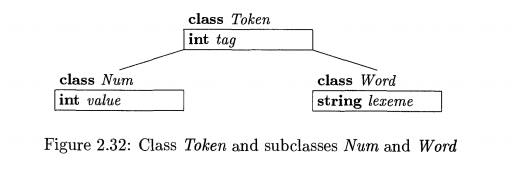
Each class is in a file by itself.
The file for class Token is as follows:
1) package lexer ; // File
Token.java
2) public class Token
{
3 ) public final int tag;
4) public Token (int t) { tag
= t; }
5) }
Line 1 identifies the package lexer.
Field t a g is declared on line 3
to be final so it cannot be changed once it is set. The constructor Token on
line 4 is used to create token objects, as in new Token ('+')
which creates a new object of class Token and sets its field tag to an
integer representation of ' + '. (For brevity, we omit the customary method t o
String , which would return a string suitable for printing.)
Where the pseudocode had
terminals like n u m and id, the Java code uses integer constants. Class Tag
implements such constants:

In addition to the integer-valued
fields NUM and ID, this class defines two addi-tional fields, TRUE and FALSE,
for future use; they will be used to illustrate the treatment of reserved
keywords.7
The fields in class Tag are public, so they can be used outside the package.
They are static , so there is
just one instance or copy of these
fields. The fields are final , so
they can be set just once. In effect, these fields represent constants. A similar
effect is achieved in C by using define-statements to allow names such as NUM
to be used as symbolic constants, e.g.:
#define NUM 256
The Java code refers to Tag. NUM
and Tag. ID in places where the pseudocode referred to terminals n u m and id.
The only requirement is that Tag.NUM and Tag. ID must be initialized with
distinct values that differ from each other and from the constants representing
single-character tokens, such as ' +' or ' *' .
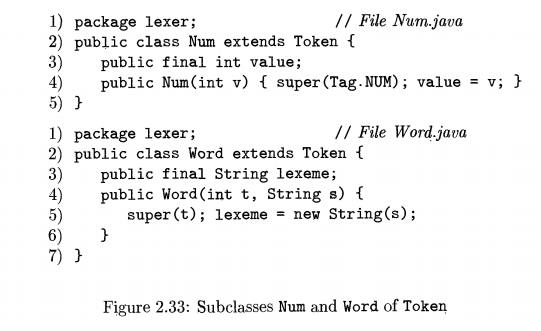
Classes Num and Word appear in
Fig. 2.33. Class Num extends Token by declaring an integer field value on line
3. The constructor Num on line 4 calls super (Tag. NUM), which sets field tag
in the superclass Token to Tag. NUM.
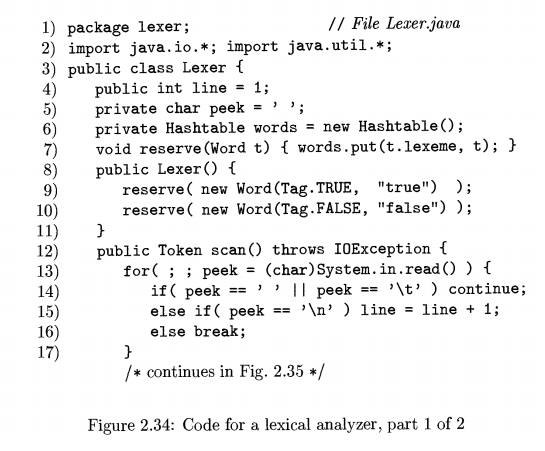
Class Word is used for both reserved words and identifiers, so the constructor Word on line 4 expects
two parameters: a lexeme and a corresponding integer value for
tag. An object for the reserved word true can be
created by executing
new Word(Tag.TRUE, "true")
which creates a new object with field tag set to Tag.TRUE and
field lexeme set to the string "true".
Class Lexer for lexical analysis appears in Figs. 2.34 and 2.35. The
integer variable line on line 4 counts input lines, and character variable peek on line 5 holds
the next input character.
Reserved words are handled on lines 6 through 11. The
table words is declared on line 6. The helper function reserve on line 7 puts a string-word pair in the table. Lines 9 and 10 in the
constructor Lexer initialize the table. They use the constructor Word to
create word objects, which are passed to the helper function reserve. The
table is therefore initialized with reserved words "true" and "false" before the first call of
scan.
The code for scan in Fig. 2.34-2.35 implements the pseudocode fragments in this section. The for-statement
on lines 13 through 17 skips blank, tab, and newline characters. Control leaves the
for-statement with peek holding a non-white-space character.
The code for reading a sequence of digits is on lines 18 through 25. The
function isDigit is from the built-in Java class Character. It is
used on line 18 to check whether peek is a digit. If so, the code on lines 19 through 24
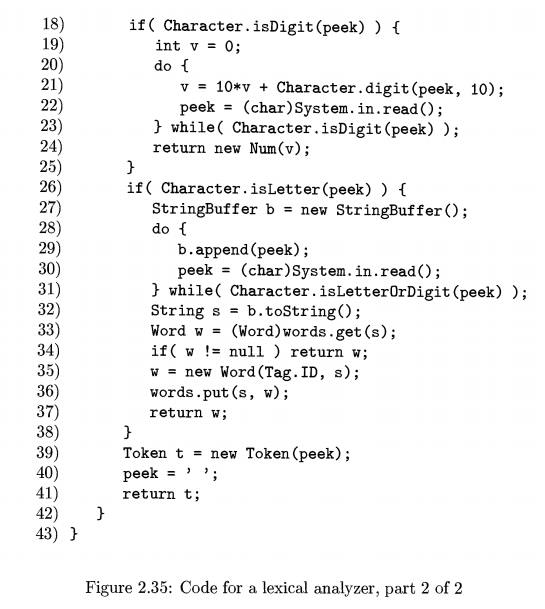
accumulates the integer value of the sequence of digits in the input and
returns a new Num object.
Lines 26 through 38 analyze reserved words and
identifiers. Keywords true and false have already been reserved on
lines 9 and 10. Therefore, line 35
is reached if string s is not
reserved, so it must be the lexeme for an identifier. Line 35 therefore returns a new word object with lexeme set to s and tag set to Tag. ID. Finally, lines 39
through 41 return the current
character as a token and set peek to
a blank that will be stripped the next time scan is called.
6. Exercises for Section 2.6
Exercise 2 . 6 . 1 : Extend the lexical analyzer in Section 2.6.5 to remove com-ments, defined as follows:
A comment begins with // and
includes all characters until the end of that line.
A comment begins with /* and
includes all characters through the next occurrence of the character sequence
*/ .
E x e r c i s e 2 . 6 . 2 :
Extend the lexical analyzer in Section 2.6.5 to recognize the relational
operators <, <=, ==, !=, >=, >.
E x e r c i s e 2 . 6 . 3 :
Extend the lexical analyzer in Section 2.6.5 to recognize float-ing point
numbers such as 2 . , 3 . 14, and . 5.
Related Topics